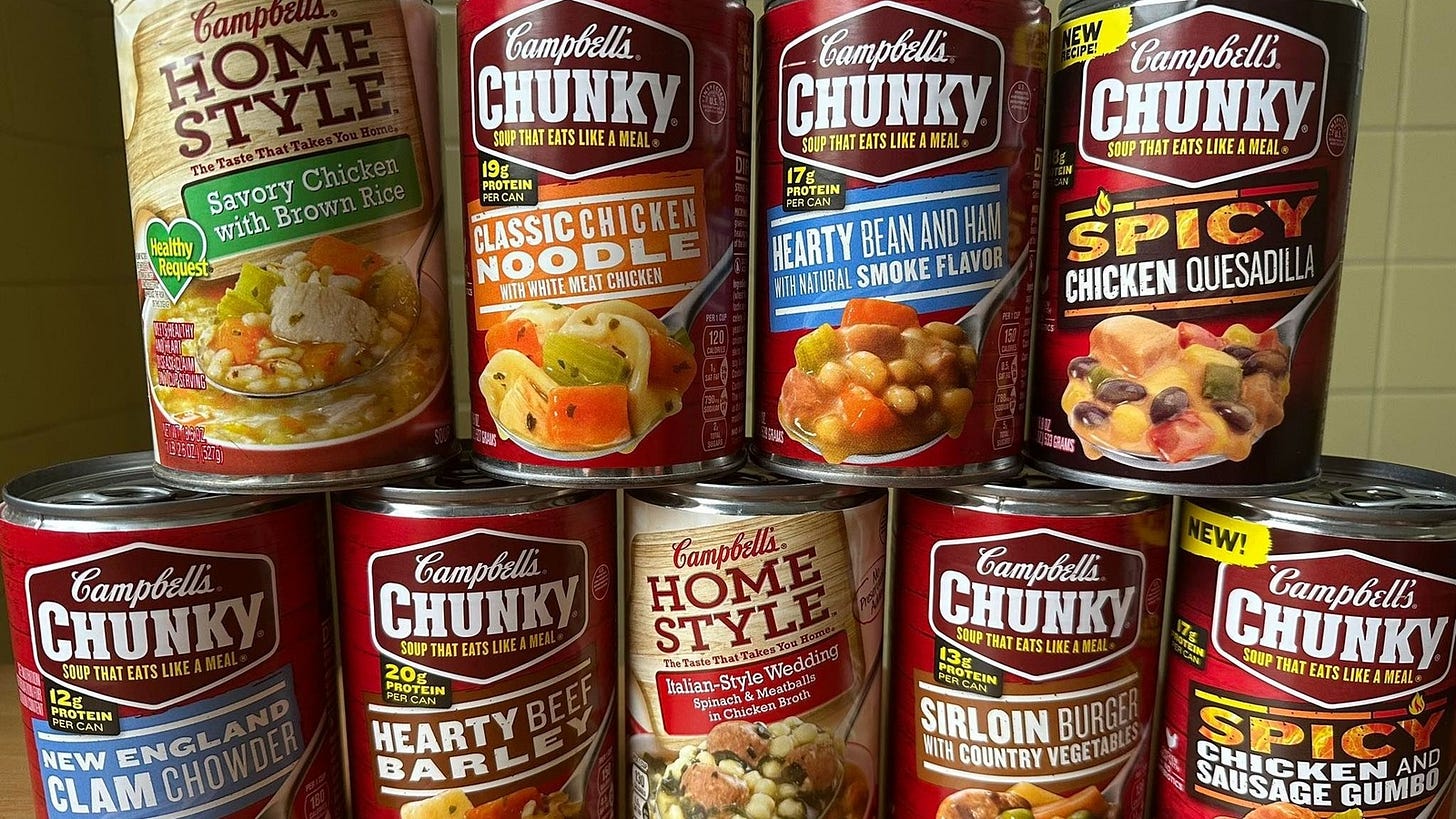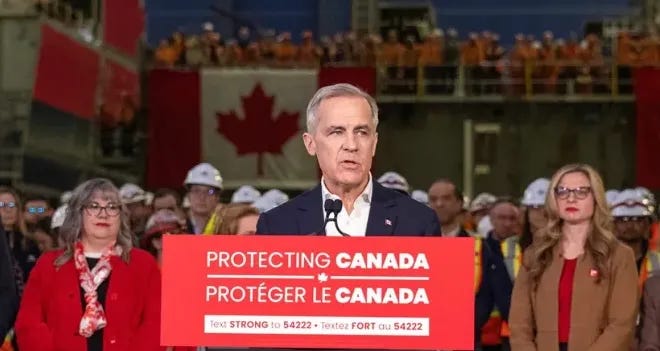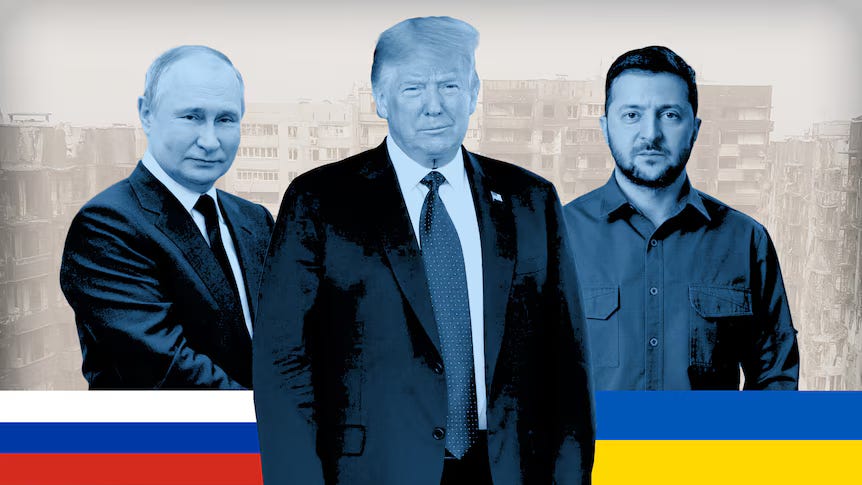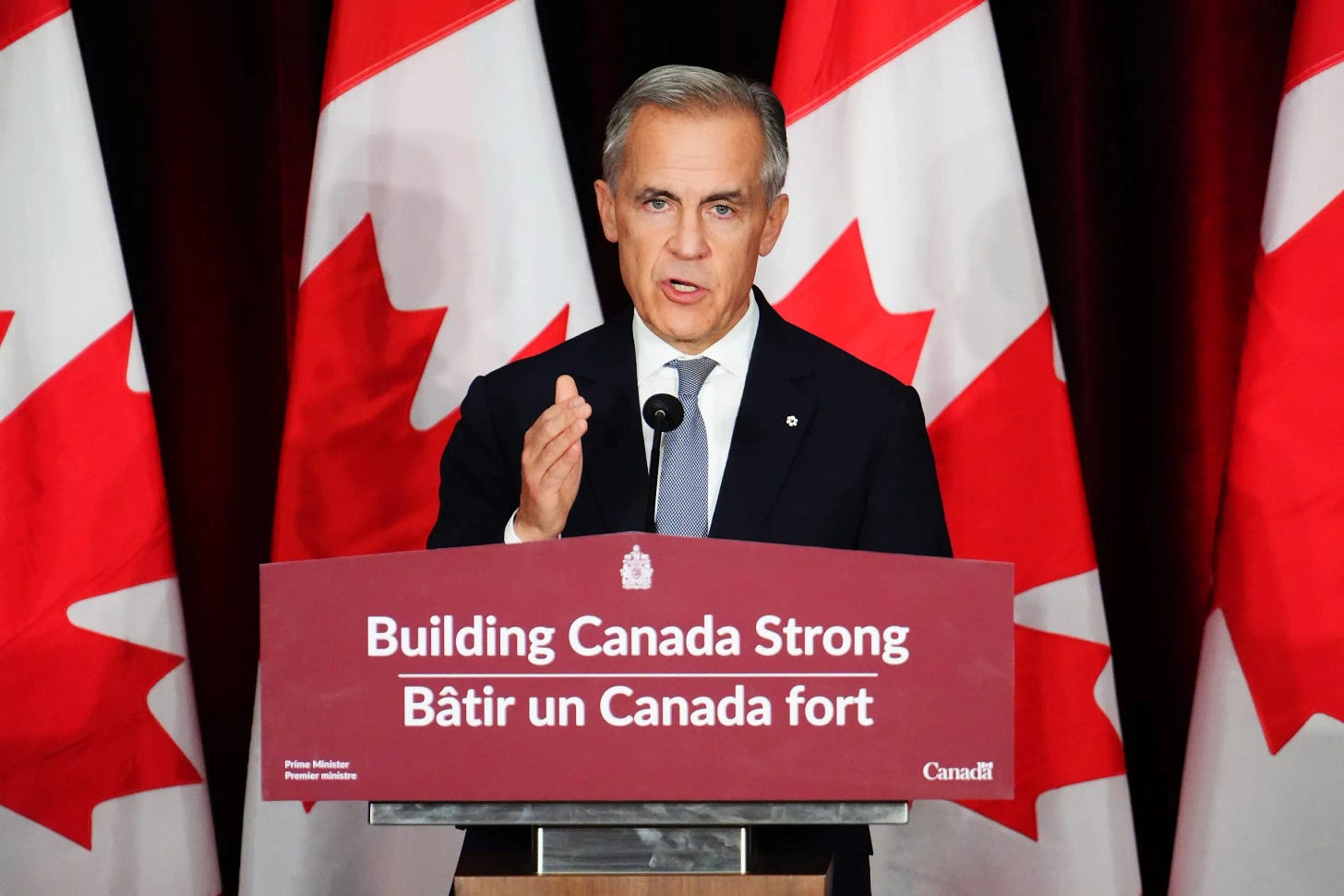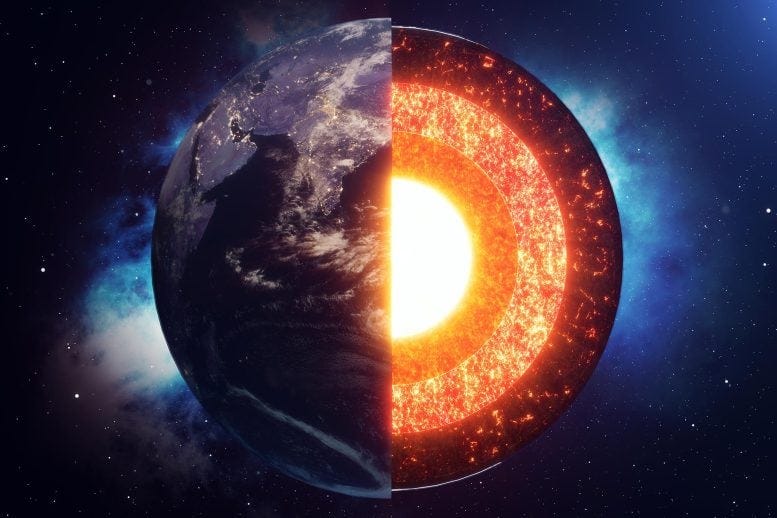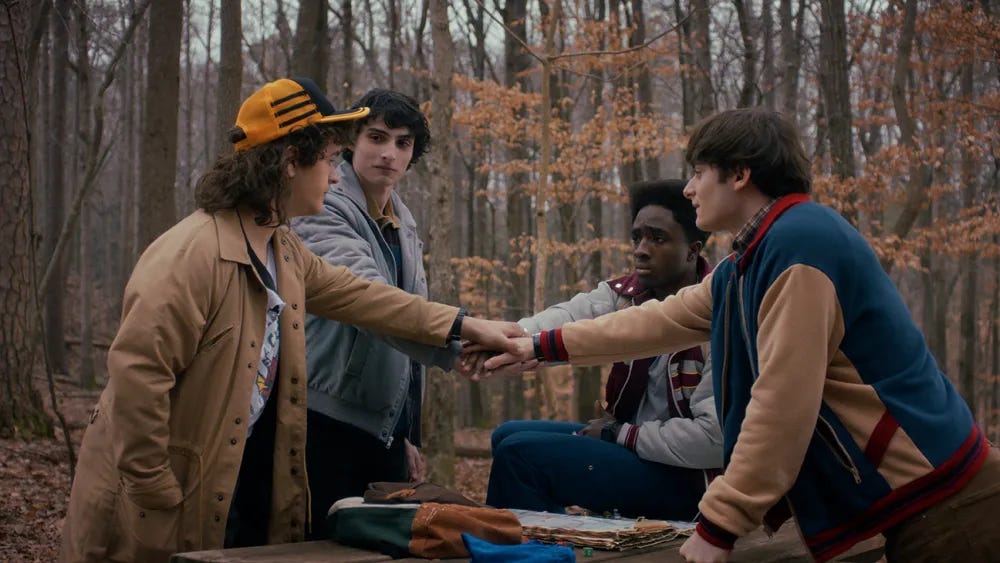Good morning, it’s Tuesday, November 25th. In today’s news, Campbell’s Vice President was caught admitting the company uses 3-D printed chicken in their soup, the Liberal government says they are finally ready to rollout the gun buyback program across Canada, Scott Adams breaks-down the five levels of awareness, Russia rejects Europe’s peace plan, and much more.
First time reading the daily blend? Sign up here.
“I Don’t Want 3-D Printed Chicken”: Campbell’s VP Caught Trashing Company Food in Secret Tape
A Campbell’s VP was caught admitting he won’t eat the companies food because they use 3-D printed chicken and bioengineered meat. That’s where we are: a food system racing toward lab-grown substitutes while the people inside it quietly try to avoid the very products they sell. The senior executive was secretly recorded saying he barely touches Campbell’s food because it’s unhealthy and “for poor people.”
The recording is more than an embarrassment. It’s an unfiltered look at how one of North America’s biggest food brands talks when the public isn’t supposed to hear.
The employee who captured the audio says he sat through an hour-long rant from Martin Bally, the company’s vice president and chief information security officer. Bally didn’t hold back. He mocked Campbell’s consumers, bragged about showing up to work high, and he dismissed the company’s own products as the kind of processed junk he refuses to eat.
The part that hit hardest — and now sits in a lawsuit — is Bally sneering at “bioengineered meat” and saying he doesn’t want “a piece of chicken that came from a 3-D printer.” That line would sound like satire if it came from a random critic. But it came from a man who helps oversee a major food company. He knows what goes into the products. He knows what’s changing in the industry. And he still said no thanks.
The employee, Robert Garza, says he reported the behaviour. Twenty days later, he was fired.
Campbell’s insists the comments don’t reflect its values. But when an executive at that level speaks that freely, it shows something deeper than one bad actor. It shows a growing gap between what industry insiders know about modern food production and what they expect the public to accept without question.
And that’s where this ties into what’s happening in Canada.
Health Canada recently tried — very quietly — to reclassify cloned beef and pork so they could be sold without labels or a safety review. No press release but rather a silent policy shift that would have allowed cloned meat into grocery stores with no warning. Only after public backlash did Ottawa pause the plan. Not because they wanted to. Because they were caught.
So you have a strange, telling pattern: a top executive mocking the idea of printed or engineered meat… while government regulators try to clear the runway for similar technologies without consumer knowledge.
The message from both corners is the same. People don’t need to know what they’re eating. People don’t need a choice. People will take what they’re given.
And once you hear that a food executive refuses to eat his own products — you can’t unsee the wider truth. The people who make the food don’t trust the system either. And that should worry every family that still buys what they sell.
Federal Government Says They Are Finally Ready to Roll Out Gun Buyback Program Across Canada
The Liberal government’s long-promised gun buyback program is supposedly “rolling out across Canada,” but after years of delays, pilot projects, and repeated amnesties, it’s hard to take Ottawa’s promises seriously. Public Safety Minister Gary Anandasangaree says the program will expand following a pilot in Nova Scotia that aimed to collect just 200 “assault-style” firearms—but participation numbers remain a mystery, as the government has so far refused to provide them.
This marks the third extension of the original amnesty, which was first set to expire in 2022. The Liberals’ buyback scheme has already handed out $22 million in compensation for more than 12,000 firearms from businesses, yet provinces like Alberta and Saskatchewan oppose it, and the Ontario Provincial Police have outright refused to enforce it.
Meanwhile, critics point out that Ottawa is once again targeting law-abiding gun owners while ignoring the flow of smuggled firearms that actually fuel crime. Even the minister in charge has admitted doubts about the program’s effectiveness and municipal police capacity to enforce it—but Prime Minister Carney insists he still has “confidence” in him.
With $742 million budgeted and billions more wasted on bureaucratic hand-wringing over “efficient implementation,” Canadians have to ask: after years of pilot projects, repeated extensions, and endless foot-dragging, will this program ever actually work—or should it even exist at all?
The Five Levels of Awareness: A Simple Map for Understanding How People Think
Every once in a while, someone offers a model of the world that isn’t meant to be “true” in a scientific sense, but useful as a way of seeing. Scott Adams’ breakdown of “levels of awareness” is exactly that — a frame for understanding how people think, why they talk past each other, and why certain conversations never seem to land. Whether one accepts the entire structure is beside the point. The utility lies in the pattern it reveals.
The first stage is Innocence. This is childhood — not merely in age but in mindset. It’s the stage where authority is trusted by default. Parents, teachers, institutions: their words are taken as they are given. The world comes pre-packaged, and the young mind accepts it.
Then comes the Truther. This is the moment a person realises authority can lie — about Santa Claus, about rules, about motives. Facts become the gold standard. Evidence becomes the anchor. But the fixation on “truth” becomes its own vulnerability: if the truth is always something handed down by someone else, then the person searching for it is always downstream of whoever controls the narrative. The Truther believes they are independent, but often they are simply choosing which authority to trust.
The third stage is the Skeptic. This person questions assigned truths rather than absorbing them. They reject pre-loaded answers. Skepticism protects them from manipulation, but it can also trap them in negation — defined more by what they doubt than what they build.
Beyond that is the Strategist. This stage shifts focus from “what is true” to “what works.” The Strategist knows they can’t know everything with certainty, but they can observe cause and effect. They can build systems, refine habits, and develop skills. They trade purity for effectiveness.
The final stage is the Author. This is not someone who rewrites reality in a mystical sense, but someone who behaves as if they can. They operate with such clarity of intention and confidence in their vision that outcomes seem to bend in their direction. They move beyond truth and beyond strategy into agency — the belief that the world is malleable.
These levels aren’t rigid, and people shift between them. But as a framework, they explain why debates seem impossible and why some people navigate the world with ease while others feel stuck. Awareness isn’t just about knowledge; it’s about the lens through which you interpret your place in the world. Source.
Kremlin Rejects Europe’s Peace Plan, Trump-Zelensky Talks to Decide Ukraine’s Fate
The Kremlin has rejected the European counterproposal to Donald Trump’s 28-point peace plan for Ukraine, calling it “unconstructive” and saying it “does not work for us.” While the US-backed plan was seen by Moscow as favorable—allowing Russia influence over territorial and security outcomes—the European plan, drawn up by Britain, Germany, and France, included stricter conditions. Key differences included restrictions on Russian control of Ukrainian territory, limitations on Russia’s military influence, and tighter requirements for Ukrainian sovereignty, including provisions that could prevent Russia from fully reclaiming territory or influence. The plan also placed constraints on Ukraine’s internal governance, including election oversight that could limit pro-Russian political gains, and conditions on troop deployments that would restrict Russian leverage.
Negotiators from the US and Ukraine have now drafted a 19-point framework, with Zelensky and Trump expected to meet in Washington to resolve the remaining sticking points, including territorial disputes and security arrangements. More
Carney Pledges Over $1 Billion to a Foreign Health Fund as Canadians Struggle at Home
Mark Carney has committed $1.02 billion to the Global Fund—putting Canadian taxpayers on the hook at a time when affordability at home is spiraling. The pledge, announced in Johannesburg, will fund malaria, TB, and HIV programs in developing nations from 2027 to 2029.
The commitment comes as other major donors, including Germany and the UK, scale back their contributions. The US has yet to confirm a pledge, and President Trump did not attend the summit.
With inflation, housing costs, and spending restraint dominating domestic concerns, Ottawa’s billion-dollar promise is already drawing sharp criticism. More
US Lawmaker Asks Canada to Pay $300 Billion for NATO Spending Shortfall - Thom Tillis, a Republican senator from North Carolina, said he has a “serious frustration” with NATO countries that failed to meet the minimum spending goal of 2 percent of their GDP on defence over the last 20 years. The consequence, he said, is a $2 trillion shortfall, with “$300 billion from Canada alone.” More
Federal Judge Dismisses Indictments of FBI Director James Comey and NY AG Letitia James - The federal judge dismissed the case, ruling that the prosecutor who brought the indictments had been invalidly appointed. It’s likely these cases will be appealed. More
US to Designate Muslim Brotherhood as a Foreign Terrorist Organization - The Muslim Brotherhood “advocates a bottom-up, gradual Islamization of society that would eventually lead to the formation of a purely Islamic society and political entity,” according to George Washington University’s Program on Extremism. More
Multiple International Airlines Cancel Venezuela Flights Following US Warning - The flight advisory will last for 90 days, the FAA said. More
China-Japan Row Deepens:
Japan Plans to Deploy Missiles on Island Near Taiwan - More
China Simulates Jamming Starlink Over Taiwan - The Chinese military study concluded that jamming Starlink satellite communications over Taiwan would require a massive airborne force. More
Ethiopia’s Hayli Gubbi Volcano Erupts After 12,000 Years - Satellite and VAAC data show a large SO₂ plume and ash drifting across Yemen, Oman, India, and northern Pakistan. More
Amazon to Invest $50 Billion Expanding AI and Supercomputing Infrastructure for US Gov
Amazon announced a $50 billion investment to expand AI and supercomputing capabilities across AWS Top Secret, AWS Secret, and GovCloud (US) regions, set to break ground in 2026. The initiative will add nearly 1.3 gigawatts of compute capacity and provide federal agencies with access to advanced AI tools, including Amazon SageMaker, Bedrock, Anthropic Claude, AWS Trainium chips, and NVIDIA infrastructure.
The expansion aims to accelerate government missions—from national security and defense to scientific research—by enabling real-time analysis of massive datasets, autonomous simulations, and AI-driven decision-making. The investment builds on AWS’s decades-long leadership in government cloud infrastructure, reinforcing America’s technological edge and supporting the Administration’s AI Action Plan. More
Bitcoin Funds Head for Worst Month as $3.5 Billion Pulled - BTC was trading at just $85k earlier today. More
Novo Nordisk Shares Plunge 9%—to Four-Year Low—After Semaglutide Trial Fails to Hit Key Alzheimer’s Target - More
Mysterious Structures Discovered Beneath Earth May Explain Why Our Planet Supports Life
Researchers have uncovered massive, mysterious structures deep within Earth that may help explain why our planet supports life. These formations—large low-shear-velocity provinces and ultra-low-velocity zones—lie nearly 1,800 miles below the surface, at the boundary between the mantle and core. A study led by Rutgers geodynamicist Yoshinori Miyazaki suggests they formed from a “basal magma ocean” contaminated by material leaking from the core, preventing clear chemical layering in the mantle. This deep-Earth mixing may have influenced how Earth cooled, how volcanic activity unfolded, and how its atmosphere developed, helping to create the conditions for oceans and life. The findings provide new insights into Earth’s early evolution and its unique habitability. More
New Study Suggests Mars Was Habitable for ‘Eons’ - The study also suggests that, roughly 4.2 to 3.7 billion years ago, Mars’ rivers, lakes, and extensive oceans started disappearing as solar wind slowly stripped away its atmosphere. More
Study: Sleep Apnea Dramatically Raises Parkinson’s Risk - More
Stranger Things: 10 Things The Duffer Brothers Want You to Know Before Watching the Final Season
As the final season of Stranger Things approaches, the Duffer brothers highlight the 10 things they want fans to keep in mind:
Story Comes Full Circle – Season 5 ties back to seasons 1 and 2, answering long-standing mysteries, including Vecna’s connection to Will.
Rewatch Key Episodes – Recommended episodes to refresh:
S2E4 “Will the Wise”
S2E6 “The Spy”
S4E7 “The Massacre at Hawkins Lab”
S4E9 “The Piggyback”
Volume 2 & Finale Prep – Don’t overthink fan theories; just enjoy the ride
Set the Mood with Music – Classics include Kate Bush’s Running Up That Hill, The Clash’s Should I Stay or Should I Go, Moby, Peter Gabriel, Toto, and some Joy Division.
Monsters Return, No New Ones – The focus is on previously established threats like Vecna, amping up the stakes without overstuffing.
Epic Finale in Theaters – Season 5 finale premieres in cinemas on Dec. 31, offering a shared, cinematic experience.
Most Complicated Scene Yet – One scene with kids, extras, and stunts posed huge logistical challenges for the creators.
Fan Theories – Most are wrong; Eddie Munson remains dead, despite speculation.
Creators Excited for Reactions – The Duffers love seeing fan responses and anticipate emotional moments.
Spinoff Setup – Stranger Things: Tales from ’85 (2026) is separate from Season 5, set between seasons 2 and 3 as an animated series for younger audiences.
The final season drops on Netflix on Nov. 26, 2025
Portland Trail Blazers Coach Chauncey Billups Pleads Not Guilty to His Role In Rigged, Mafia-Backed Betting Scheme—He Was Released on $5 Million Bail - More
Shedeur Sanders to Start for the Browns in Week 13 Against the 49ers - More
The 100 Best Comedy Movies of All Time According to Variety - More
The ShamWow Guy is Running for US House Rep Seat in Texas
‘Engraved with Initials’: Titanic Passenger’s Gold Pocket Watch Fetches £1.78M, Smashes Memorabilia Auction Record
On This Day in 1947, Hollywood launches its first systematic blacklist, barring entertainment professionals over ties to communism






